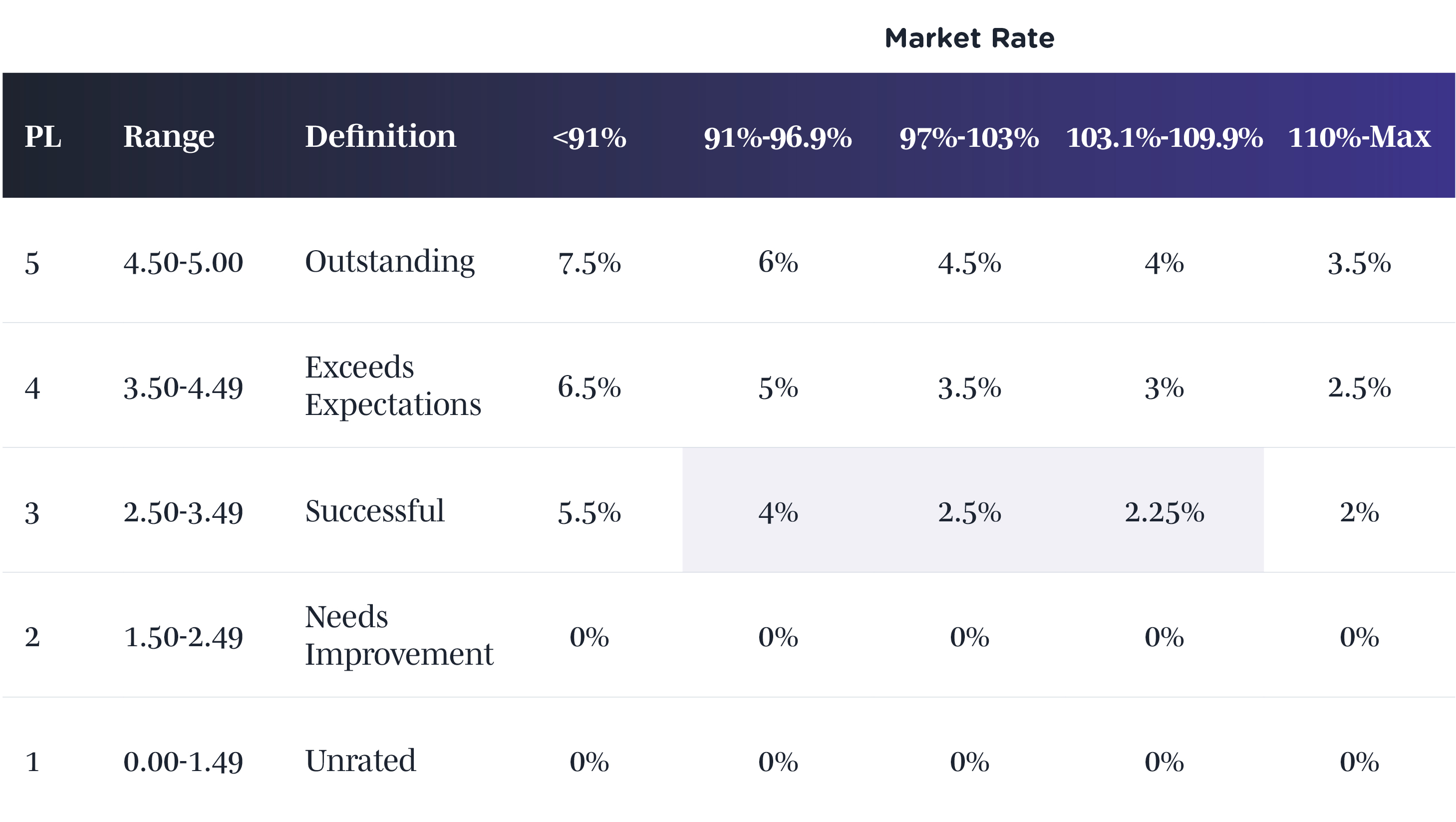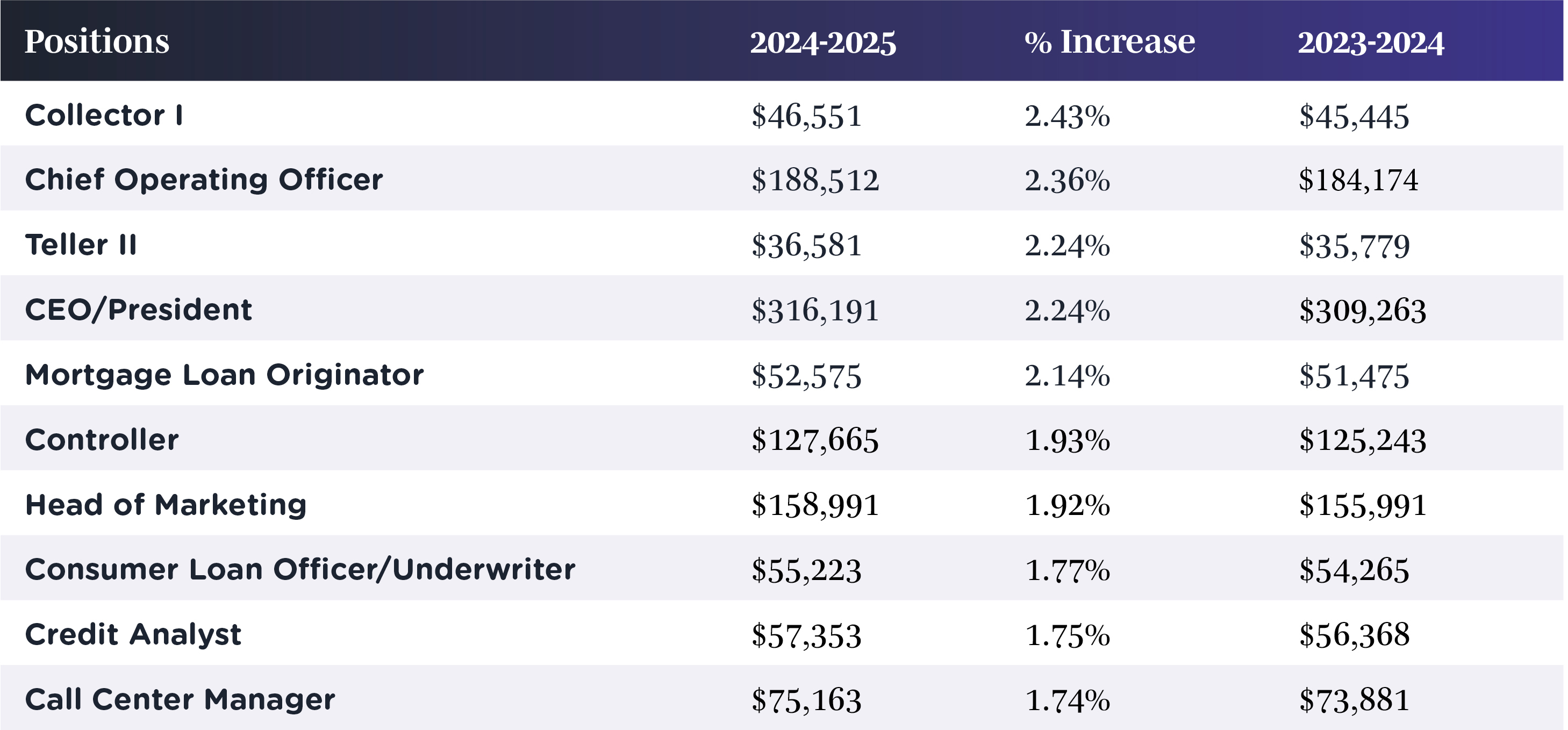By Christie Summervill

The labor market is starting to cool off after record-high pay raises in 2023 and 2024. Last year was the year of the outlier for the banking industry, with some jobs, like IT Business Analyst, seeming to have salary growth of up to 40% over the past two years in at least one national survey. This year, salary movement for most positions is fairly standard with a 3% average midpoint movement. Even the hottest jobs possess a salary movement that tops at 13%.
The average projected salary structure movement (from the 2024 midpoint to the 2025 midpoint) for exempt and non-exempt employees is around 3.0%. The average labor budget is projected to be 3.9-4.2%.
A typical 3.5-4.0% salary increase would leave little to reward performance or move pay levels closer to the midpoint. I recommend a 4.5% labor budget because other compensation surveys that report average labor budgets of 4.0% have a separate line item budgeted for promotions, whereas banks and credit unions do not. This forces them to be out of budget or finance the promotion with attrition when others quit if they aren’t filling the role.
By advocating that your 2024 salary budget be increased to 4.0-4.5%, you will reduce the level of unnecessary turnover and help ensure that those you would typically promote one year later into other positions will still be onboard.
“Not budgeting this amount could be the worst money ever saved.”
When developing an effective labor budget matrix, keep your eye on the percentage where “Meets Expectation” intersects with the “Market Rate Compa Ratio” (between 97-103%) at all costs. In 2025, that number projects at 3.0%. Consider how much salary increase your top-rated performers should receive over your “Meets Expectations” rated performers. A typical 1% pay difference between higher-performing and average-performing employees sends the message that “performance does not pay here,” leading to higher turnover, quiet quitting, acting your wage, and other toxic employee responses that drain productivity from the organization.
Ideally, your range of performance classes should have at least a 2% difference to account for “paying for performance” among your highest-performing employees. Paying this difference ensures that higher-performing employees’ pay levels move closer to the midpoint more quickly, reducing the need to spend time on recruiting sites. Too often, only employees whose managers are willing to go to bat for them receive a higher salary increase.
If a non-exempt employee is new to the company or the position due to an internal hire, their compa ratio should be 85% of the midpoint. The same applies to executives if the company recently moved its peer comparison group into a larger asset size. By having a starting pay at 80% of the midpoint, you’re essentially saying, “Our starting pay is at a level that less than 10% of our competitors would pay.” You need an additional 5% over the 3.5% so that their pay level will meet the market rate expectation within three years if you are operating in a regular market (See Matrix A). Exempt employees should reach their midpoint within five years, with their difference set at a 2.5% market rate movement year-over-year, which is down from last year (See Matrix B).
Matrix A: Nonexempt to Midpoint in 3 Years
Matrix B: Exempt to Midpoint in 5 Years

*Data last updated on 10/22/24.
Hot jobs with salary movement twice as fast as the market may need a 10% premium added to their midpoint before running your budget. This is preferable to over-grading. On the list of fastest-moving salaries in the BalancedComp 2024-2025 salary survey are some jobs we expect to see each year, like Information Security Officer, Chief Lending Officer, Senior Trust Officer, Digital Marketing Specialist, Senior Project Manager, and Software Engineer. It also included some surprises, such as a Payroll Specialist, Recruiter, Operations Rep II, Benefits Specialist, and HR Generalist.
Fastest-Moving Salaries

Slowest-Moving Salaries

Not all jobs have skyrocketing salaries. Interestingly, wages for roles like Call Center Manager, Credit Analyst I, Consumer Loan Officer, Head of Marketing, and Controller were significantly less than the average market rate movement. All of these were on the fastest-growing list just last year. It is critical to know which jobs are moving faster or slower than the market, or you might apply the same midpoint movement to all jobs in a grade and mistake the compa ratio to be an accurate indicator of how the individual is paid compared to the midpoint.
If you cannot get approval on a 4% labor budget, it would be advisable to lessen the difference for performance to 1.5% over slowing down movement to the midpoint. Recruiters have made a fortune in the past two years by recruiting employees with five years of experience in their roles but who are paid under the midpoint salary. The average salary increase for those who left for money was 16.1%. They likely didn’t have to find jobs that paid outside of the salary range of the current employer if their previous employer had the discipline of moving pay levels to midpoint over a reasonable period.
The liquidity market has proven to be a disincentive to make an effort to move salaries of effective employees to the midpoint over a realistic period and instead choose to wait until turnover becomes a threat again.
Having a family-friendly work environment and a positive work culture is a minimum expectation and will not suffice to keep good employees. High-performing financial institutions continue to focus on correcting salaries to get them closer to the midpoint despite struggling with the current interest rate environment.
We make this process easier for our clients with our best-in-industry web-based software, packed with data from over 20 credible sources, all tailored by asset size and geographic location, and our team of expert HR consultants. Our compensation and salary experts help ensure that every financial institution develops a pay-for-performance culture while aligning with market data. To learn more about our flagship BalancedComp salary administration software, please schedule a demo today.
Back to Blog


